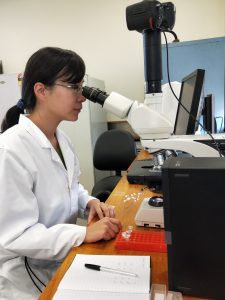Insights into Spongospora root diseases and its management
The Tasmanian Institute of Agriculture has recently started a three-year strategic levy investment to improve the understanding of and develop control strategies for Spongospora root diseases of potato. In this article, PhD student Xian Yu outlines her component of the project and how it may limit the impacts of this disease.
A research team at the Tasmanian Institute of Agriculture (TIA) is embarking on a new project aimed at improving the fundamental understanding of the recalcitrant soilborne pathogen Spongospora subterranea that causes root infection and reduces yield capacity of commercial potato crops.
During root infection, the powdery scab pathogen releases motile zoospores that swim toward and bind onto root surfaces leading to infection and disease. Once the zoospores reach the root, they attach to the root surface and the content of the zoospore is then injected into the root cell. The efficiency of root attachment impacts on subsequent disease development.
“Preliminary evidence suggests that cultivars that show resistance to root infection also show reduced efficiency of root attachment compared to susceptible cultivars,” TIA PhD student Xian Yu explained.
“My PhD project will utilise this root attachment response to develop a rapid and robust laboratory screening tool that will enable me to efficiently screen hundreds of potato cultivars for resistance to powdery scab within weeks, instead of the traditional glasshouse or field methods, which require many months at much greater expense.”
Xian will then conduct proteomic studies to examine proteins on the root surface associated with zoospore attachment.
“This information will help us understand what makes a resistant root resistant, and it may be possible to manipulate the zoospore binding via the use of blocking agents to prevent root infection and disease,” she said.
Project Lead Professor Calum Wilson said that this fundamental PhD study targeting the initial plant-pathogen interaction was a key prerequisite for better understanding of the disease and the development of solutions for the potato industry.
Tasmanian Institute of Agriculture (TIA) PhD student Xian Yu. Image courtesy of TIA.
Industry targeted outcomes
While the project will provide Xian with scientific training in plant pathology research, she believes that her work will also have significant industry benefits.
“Determining the relative resistance to powdering scab will allow industry stakeholders to make informed decisions on which variety they should grow to minimise root disease,” Xian said.
“New varieties will be able to be screened for disease resistance, more accurately, more rapidly and for much less cost, than traditional methods. Identification of key traits associated with resistance, such as root surface receptor proteins and associated gene markers, could in the future be used to identify resistant potato genotypes and develop novel options that could block root attachment and completely prevent disease.”
Find out more
For more information about this project, please contact Professor Calum Wilson at calum.wilson@utas.edu.au.
Mechanisms and manipulation of resistance to powdery scab in potato roots is a strategic levy investment under the Hort Innovation Potato – Fresh and Potato – Processing Funds.
This project is funded by Hort Innovation, using the fresh and processing potato research and development levies, in-kind contributions from the Tasmanian Institute of Agriculture and contributions from the Australian Government.
Project Number: PT17003


